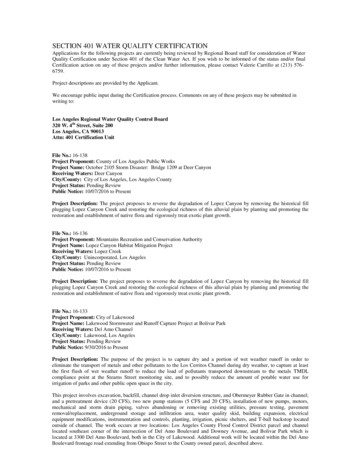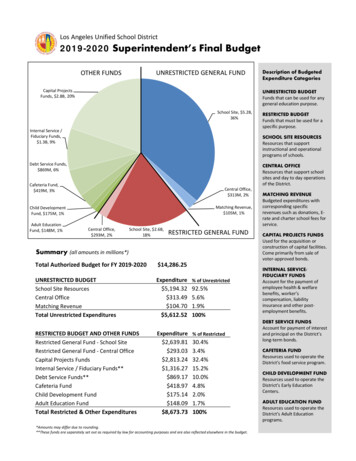
Transcription
Los Angeles Unified School District2019-2020Superintendent’s Final BudgetUNRESTRICTED GENERAL FUNDOTHER FUNDSCapital ProjectsFunds, 2.8B, 20%UNRESTRICTED BUDGETFunds that can be used for anygeneral education purpose.School Site, 5.2B,36%Internal Service /Fiduciary Funds, 1.3B, 9%RESTRICTED BUDGETFunds that must be used for aspecific purpose.SCHOOL SITE RESOURCESResources that supportinstructional and operationalprograms of schools.Debt Service Funds, 869M, 6%CENTRAL OFFICEResources that support schoolsites and day to day operationsof the District.Cafeteria Fund, 419M, 3%Central Office, 313M, 2%Matching Revenue, 105M, 1%Child DevelopmentFund, 175M, 1%Adult EducationFund, 148M, 1%Description of BudgetedExpenditure CategoriesCentral Office, 293M, 2%School Site, 2.6B,18%RESTRICTED GENERAL FUNDSummary (all amounts in millions*)Total Authorized Budget for FY 2019-2020 14,286.25UNRESTRICTED BUDGETSchool Site ResourcesCentral OfficeMatching RevenueTotal Unrestricted ExpendituresExpenditure 5,194.32 313.49 104.70 5,612.52RESTRICTED BUDGET AND OTHER FUNDSRestricted General Fund - School SiteRestricted General Fund - Central OfficeCapital Projects FundsInternal Service / Fiduciary Funds**Debt Service Funds**Cafeteria FundChild Development FundAdult Education FundTotal Restricted & Other ExpendituresExpenditure 2,639.81 293.03 2,813.24 1,316.27 869.17 418.97 175.14 148.09 8,673.73% of Unrestricted92.5%5.6%1.9%100%% of *Amounts may differ due to rounding.**These funds are separately set out as required by law for accounting purposes and are also reflected elsewhere in the budget.MATCHING REVENUEBudgeted expenditures withcorresponding specificrevenues such as donations, Erate and charter school fees forservice.CAPITAL PROJECTS FUNDSUsed for the acquisition orconstruction of capital facilities.Come primarily from sale ofvoter-approved bonds.INTERNAL SERVICE/FIDUCIARY FUNDSAccount for the payment ofemployee health & welfarebenefits, worker’scompensation, liabilityinsurance and other postemployment benefits.DEBT SERVICE FUNDSAccount for payment of interestand principal on the District’slong-term bonds.CAFETERIA FUNDResources used to operate theDistrict’s food service program.CHILD DEVELOPMENT FUNDResources used to operate theDistrict’s Early EducationCenters.ADULT EDUCATION FUNDResources used to operate theDistrict’s Adult Educationprograms.
Los Angeles Unified School District2019-20SUPERINTENDENT’S FINAL BUDGETINTRODUCTIONLAUSD’s budget is large and complex. The chart below shows the hierarchy of LAUSD’s fundstructure based on California’s Standardized Account Code Structure (SACS). This will guide andhelp the reader understand the LAUSD’s budget and its various components.District-defined ProgramsThe following pages in this section are designed to look at LAUSD’s fund structure from the overalltotal budget drilling down to the General Fund, which is the largest Operating Fund of LAUSD.Therefore, this section of the budget overview will focus on the General Fund.1
Los Angeles Unified School District2019-20SUPERINTENDENT’S FINAL BUDGETTHE TOTAL BUDGETAs required by California law, LAUSD’s budget is classified and reported by “fund”. The funds arecategorized and grouped based on the use of the funds as follows:1. Operating Funds, as discussed further below, is composed of the General Fund, Adult EducationFund, Child Development Fund, and Cafeteria Fund. These funds are used for the day-today operation of LAUSD schools and offices.2. Capital Projects Funds for the purpose of acquisition or construction of capital facilities. Thefunding comes primarily from the sale of voter-approved bonds. These funds may not be usedfor the general day-to-day operations, as voters approved them for specific capitalizedprojects which will benefit current and future students.3. Debt Service Funds are used for the payment of interest and principal of long-term bonds.4. Internal Service Funds are used for the payment of employee health and welfare benefits,workers’ compensation, and liability insurance. The majority of funds accumulated in theInternal Service Funds come from funds generated by positions funded in the other funds.For example, the cost of a teacher’s health and welfare benefits funded by the GeneralFund is transferred from the General Fund to the Health and Welfare Fund, which is one ofthe Internal Service Funds.5. Fiduciary Fund is composed of the Other Post-Employment Benefit (OPEB) Fund. This fundis dedicated for the health and welfare benefits of future retirees of LAUSD.OPERATING FUNDSAs shown on the hierarchy of funds, the Operating Funds category is broken down into the followingfour individual funds:1. General Fund - includes funds for the basic instructional and administrative expendituresof the District2. Adult Education Fund - includes funds dedicated for the operation of the Adult Education program3. Child Development Fund - includes funds dedicated for the operation of theEarly Childhood Education program4. Cafeteria Fund - includes funds for the food service programsAn instructional program such as the Early Childhood Education may cost more than the revenueit generates. Therefore, a support from the General Fund is necessary. This is also true foroperational programs such as the ones offered by the Food Services Division.2
Los Angeles Unified School District2019-20SUPERINTENDENT’S FINAL BUDGETGENERAL FUNDThe General Fund includes “unrestricted” and “restricted” funds. Unrestricted General Fund – These are funds such as the Local Control Funding Formula (LCFF)Base Grant portion and one-time Mandated Cost Block Brant that can be used for any generalpurpose expenditure. Restricted General Fund – These are funds such as the AB 602 Special Education and Title I fundsthat must be used for specific purposes.The General Fund is further broken down into “District-defined Programs” as shown below.General Fund’s District-defined ProgramGeneral ProgramSpecial Education ProgramRegional Occupational ProgramOngoing and Major Maintenance AccountUnrestricted Restricted Some district-defined programs within the General Fund may also need support. An example is theSpecial Education Program which is subsidized by the General Program (unrestricted). The supportfor the Special Education Program from the General Program is called an “inter-program transfer”,where the transfer of funds occurs between District-defined programs within the General Fund.3
Los Angeles Unified School District2019-20SUPERINTENDENT’S FINAL BUDGETDESCRIPTION OF FUNDSCalifornia State law requires school districts to organize their financial reporting by “fund”. The CaliforniaSchool Accounting Manual (CSAM), which governs school district budgeting and accounting processes inCalifornia, defines “fund” as an accounting entity with a self-balancing set of accounts recording financialresources and liabilities. It is established to carry on specific activities or to attain certain objectives of aLocal Educational Agency (LEA) in accordance with special regulations, restrictions, or limitations.” (Section101, December 1998).LEAs such as the Los Angeles Unified School District are required to budget by fund. The Superintendent’sFinal Budget is comprised of a General Fund and 23 special funds. The uses of these funds are summarizedbelow.1OPERATING FUNDSFund 010: General Fund is used to account for the basic instructional, support, and administrativeoperations of the District. The General Fund includes services to regular K-12 schools, the specialeducation program, and other programs. The General Fund supports and accounts for both restricted andunrestricted funding sources and expenditures. The restricted sources are summarized in the RestrictedGeneral Fund section of this document.Fund 110: Adult Education Fund is used to account separately for federal, state, and local revenues foradult education programs, as well as for expenditures that support this program. Expenditures in the AdultEducation Fund are limited to those for adult education purposes. Moneys received for programs otherthan adult education may not be expended for adult education purposes (Education Code §52616[b]).Fund 120: Child Development Fund is used to account for federal, state, and local revenues to operatechild development programs. In the Los Angeles Unified School District, the Child Development Fundsupports the activities of the Early Childhood Education Centers that operate throughout the District. Thisfund may be used only for expenditures for the operation of child development programs and may besubsidized by the General Fund as well.Fund 130: Cafeteria Fund is used to account for federal, state, and local resources to operate the District’sfood service program (Education Code §38091 and §38100).1Definitions reflect the California School Accounting Manual descriptions where available, augmented by information fromthe District budget and the District’s 2017-18 Audited Annual Financial Report to reflect specific District use of various funds1
Los Angeles Unified School District2019-20SUPERINTENDENT’S FINAL BUDGETCAPITAL PROJECTS FUNDSBuilding Funds exist primarily to account for proceeds from the sale of bonds (Education Code §15146).Expenditures are most commonly made against Object 6000 – Capital Outlay accounts. As the result of thepassage of multiple bond elections, the District operates six separate Building Funds.Fund 210: Building Fund – Measure R accounts for the proceeds resulting from the passage ofMeasure R, a local school bond measure approved by the voters in March 2004, for new schoolconstruction and repairs to existing schools.Fund 211: Building Fund – Proposition BB accounts for the proceeds resulting from the passage ofProposition BB, a local school bond measure approved by the voters in April 1997 for constructionof new schools and repair and modernization of existing schools.Fund 212: Building Fund accounts for proceeds from the sale of bonds prior to 1997, as well asstate allowances and other resources designed for facilities expansion.Fund 213: Building Fund – Measure K accounts for the proceeds resulting from the passage ofMeasure K, a local school bond measure approved by the voters in November 2002, for new schoolconstruction and repair and modernization of existing schools.Fund 214: Building Fund – Measure Y accounts for the proceeds resulting from the passage ofMeasure Y, a local school bond measure approved by the voters in November 2005, for schoolconstruction and modernization, with the goal of returning all schools to a traditional calendar.Fund 215: Building Fund – Measure Q accounts for the proceeds resulting from the passage ofMeasure Q which was a local school bond measure approved by the voters in November 2008 tofund critical repair and safety needs, create science labs and other specialized classroomsnecessary to teach courses that would help students get into college or start careers after theygraduate, and help create classrooms that are up to date in technology and high speed internet.Fund 250: Capital Facilities Account Fund accounts for resources received from developer fees levied uponnew residential, commercial, or industrial development projects within the District’s boundaries. Thedollars are used to obtain funds for the construction or acquisition of school facilities to relieveovercrowding.Fund 300: State School Building Lease-Purchase Fund accounts for state apportionments received inaccordance with California Education Code §17700-17780, primarily for relief of overcrowding.Fund 351: County School Facilities Fund account for revenues and expenditures resulting from buildingprojects funded primarily or in part from state bond elections or from matching funds. The District used tooperate four separate County School Facilities Funds. In 2013-14, these four funds shown below wereconsolidated into one single County School Facilities Fund.2
Los Angeles Unified School District2019-20SUPERINTENDENT’S FINAL BUDGETCounty School Facilities Fund - 1A accounts for school construction and modernization fundsreceived from proceeds resulting from the passage of Proposition 1A in 1998, as well as for localmatching funds.County School Facilities Fund – Proposition 47 accounts for apportionments received from the StateSchool Facilities Fund. The passage of Proposition 47 in November 2002 authorized the sale ofbonds for new school facility construction, modernization projects, and facility hardship grants.County School Facilities Fund – Proposition 55 accounts for the matching funds received as a resultof the passage of Measure R. Proposition 55 was passed by the voters in March 2004.County School Facilities Fund – Proposition 1D provides funding from the Kindergarten- UniversityPublic Education Facilities Bond Act of 2006. Proposition 1D was approved by the voters in theNovember 2006 general election. Funds provide additional dollars for existing school facilitiesprograms. Funds also provide new dollars for seismic mitigation of the most vulnerable schoolfacilities, creation of career technical education facilities, reduction of severely overcrowded sites,and incentives for the construction of high-performance “green” schools.Special Reserve Funds for Capital Outlay Projects provide for the accumulation of General Fund moneys forcapital outlay purposes (Education Code §42840). Transfers authorized by the governing board must beutilized for capital outlay purposes. The District operates four Special Reserve Funds:Fund 400:Special Reserve Fund – Community Redevelopment Agency accounts forreimbursements of tax increment revenues from certain community redevelopment agenciesbased on agreements between the District and the agencies. The reimbursements are to be usedfor capital projects within the respective redevelopment areas covered in the agreements.Fund 401: Special Reserve Fund accounts for District resources designated for capital outlaypurposes such as land purchases, ground improvements, facilities construction and improvements,new acquisitions, and related expenditures.Fund 402: Special Reserve Fund – FEMA – Earthquake accounts for funds received from theFederal Emergency Management Agency (FEMA) for capital outlay projects resulting from theJanuary 17, 1994 Northridge earthquake.Fund 403: Special Reserve Fund – FEMA – Hazard Mitigation accounts for funds received fromFEMA and for the 25% District matching funds for the retrofit/replacement of pendant lighting andsuspended ceilings in selected buildings at schools, offices, and Early Childhood Education Centers.3
Los Angeles Unified School District2019-20SUPERINTENDENT’S FINAL BUDGETDEBT SERVICE FUNDSFund 510: Bond Interest and Redemption Fund accounts for the payment of the principal and interest onProposition BB and Measures K, Q, R, and Y bond issues. Revenues are derived from ad valorem taxeslevied upon all properties subject to tax by the District.Fund 530: Tax Override Fund accounts for the accumulation of resources from ad valorem tax levies forthe repayment of State School Building Aid Fund apportionments.Fund 560: Capital Services Fund accounts for the accumulation of resources for the repayment of principaland interest on certificates of participation (COPs) and long-term capital lease agreements. Revenues arederived primarily from operating transfers from user funds and investment income.INTERNAL SERVICE FUNDSFund 670: Health and Welfare Benefits Fund pays for claims, administrative costs, insurance premiums,and related expenditures for the District’s Health and Welfare Benefits program. Medical and dental claimsfor the self-insured portion of the Fund are administered by outside claims administrators. Premiumpayments to Health Maintenance Organizations for medical benefits and to outside carriers for visionservices, dental services, and optional life insurance are also paid out of this Fund.Fund 671: Workers’ Compensation Self-Insurance Fund pays for claims, excess insurance coverage,administrative costs, and related expenditures. An outside claims administrator manages Workers’Compensation claims for the District.Fund 672: Liability Self-Insurance Fund pays for claims, excess insurance coverage, administrative costs,and related expenditures, and to provide funds for insurance deductible amounts. An outside claimsadministrator manages liability claims for the District.FIDUCIARY FUNDSFund 713: Other Post-employment Benefits (OPEB) Fund accounts for resources to be distributed to a trustaccount for employees’ Other Post-employment Benefits.Student Body Funds at the school sites account for cash held by the District on behalf of the student bodies.The CSAM does not require that Student Body Fund moneys be reported to CDE as part of the District’sbudget. However, it must be included in the audited financial statements to meet GAAP reportingrequirements.4
Los Angeles Unified School District2019-20SUPERINTENDENT’S FINAL BUDGETSOURCES AND USES OF FUNDSSOURCES OF FUNDSBeginning BalanceThis section of the financial statements basically reflects the ending balance ofthe prior year. In addition, it may include adjustments due to audit orrestatements of amounts.RevenueThis section entails the various types of revenues received. They are classifiedbased on the source of funds such as the Local Control Funding Formula,federal, state, and local revenues. For example, entitlements or grants comingfrom the federal government such as the Federal IDEA and Title I are includedunder federal revenues; while entitlements or grants coming from the statesuch as the Special Education funding AB 602 is included in the state revenues.It may also include inter-fund transfers-in from other funds.USES OF FUNDSExpenditureThis section reflects the amounts of funds spent or to be spent based on thetype of expenditure which are called the objects of expenditures. These maybe certificated and classified employees’ salaries, employee benefits, booksand supplies, contracts, and capital outlay. It may also include inter-fundtransfers-out to other funds. Certificated Salaries include salaries for positions that require a credentialor permit issued by the Commission on Teacher Credentialing such assalaries of school administrators, teachers, librarians, counselors, nurses,and certificated central office administrators. Classified Salaries include salaries for positions that do not require acredential or permit issued by the Commission on Teacher Credentialingsuch as salaries of instructional aides, school administrative assistants, busdrivers, carpenters, custodians, plumbers, and those non-certificatedemployees who supervise their work. Employee Benefits include employers’ contributions to retirement plansand health and welfare benefits for employees, their dependents, retiredemployees, and board members; and other post-employment benefits. Books and Supplies include the cost of textbooks, instructional materials,general supplies, and fuel.5
Los Angeles Unified School District2019-20Ending BalanceSUPERINTENDENT’S FINAL BUDGET Services and Other Operating Expenses include the cost of contracts,travel and conferences, dues and memberships, utilities, rentals, leases,repairs, and professional or consulting services. Capital Outlay includes the cost of facilities (land and buildings), booksand media for new libraries or major expansion of school libraries,equipment, and equipment replacement. Most of LAUSD’s capital outlaycosts are in bond funds devoted specifically to school construction andmodernization. Other Outgo includes pass through of apportionments to county-educatedLAUSD-resident students, transfers of taxes to direct-funded (fiscallyindependent) charter schools, bond redemptions, and bond interest andother service charges.This section entails the ending fund balance for the fiscal year which areclassified into various categories. GASB 54 implemented a five-tier fundbalance classification that sets the parameters and spending constraints as touse of funds. Non-spendable Fund Balance consists of funds that cannot be spent due totheir form. These include inventory and prepaid items or funds that arelegally or contractually-required to remain intact, such as the principal of apermanent endowment. Restricted Fund Balance consists of funds that are subject to externallyimposed and legal constraints. Committed Fund Balance consists of funds that are subject to internalpolicies and constraints. These policies are self-imposed by the District’shighest level of decision-making authority. Assigned Fund Balance consists of funds that are intended to be used for aspecific purpose by the district’s highest level or an official with theauthority to assign funds.Unassigned Fund Balance consists of residual fund balance that has notbeen classified in the previous four categories. It represents resourcesavailable for future spending. 6
Los Angeles Unified School District2019-20SUPERINTENDENT’S FINAL BUDGETBUDGET AND FINANCE POLICY SUMMARYThe Board of Education adopted the District’s Budget and Finance Policy in June 2004. The Policy isintended to assist the Board of Education in making sound policy, guide the development of the District’sbudget, enhance the management of the District’s finances, minimize the risk that the District’s financialcondition will create a need for Los Angeles County Office of Education (LACOE) action, and reducepotential audit concerns. The Board and Superintendent set priorities and allocate resources through thebudget.The Budget and Finance Policy was developed based on standards from the Government Finance OfficersAssociation’s (GFOA) “Recommended Budget Practices” document. The Policy is also consistent with theState Board of Education (Education Code Sections 33127, 33128), and current Governmental AccountingStandards Board (GASB) rules and standards. In any areas that LAUSD’s budgeting and accountingpractices were not in compliance with this policy at the time of its adoption, implementation was phasedin.In February 2009, effective for the 2010-11 financial statements, GASB issued Statement No. 54 FundBalance Reporting and Governmental Fund Type Definitions. This new standard has left the total fundbalance amount unchanged, but has changed the categories, the terminology, and how the componentsof the fund balance are presented and established. The fund balance policy is intended to provideguidelines and to establish procedure for reporting fund balance.In November 2013, the District adopted an updated Budget and Finance Policy that establishes a formulathat calculates annual contributions to an Other-Post-Employment Benefit (OPEB) trust when thebalances in the general fund exceed the 5% minimum reserve threshold.Contrary to the policy of contributing to the OPEB trust when the balances in the general fund exceed the5% minimum reserve threshold, no contributions were reflected in in FY 2018-19 and FY 2019-20. Theplanned annual contributions in these fiscal years were used to address the deficits in the out-years aspart of the 2017-18 fiscal stabilization plan.The Finance and Budget Policy is a “living document,” which the District expects will evolve over time tobest connect District policy, budgeting, and financing principles. The Budget and Finance Policyenumerates various broad principles for budgeting and financial operations, as follows:Principle One: The budget should be based on the goals of the Board and Superintendent.The Board and Superintendent have the primary responsibility for developing and articulating theDistrict’s goals. As the budget is developed and presented, these goals should be considered.Principle Two: The budget should be based on sound financial principles.LAUSD’s budget should keep the District financially viable and able to sustain its key programs over time.1
Los Angeles Unified School District2019-20SUPERINTENDENT’S FINAL BUDGETThe following specific financial principles are explained in detail in the full Budget and FinancePolicy document: Balanced Operating Budget Alignment of Budget with Expected Expenditures Adequate Reserves Revenue Maximization Revenue Estimation Cost Recovery Through Fees and Charges Multi-Year Capital Plan and Budget Asset Management Equipment Replacement Prudent Debt Management Program Sustainability GASB CompliancePrinciple Three: The budget should be clear and easy to understand.The budget should be organized and presented in such a way that readers can understand: What the District intends to do and how it intends to do it The District’s overall financial condition The historical context for LAUSD programsConsistent with the GFOA standards, LAUSD has identified guidelines for the presentation ofbudgets. These standards provided guidance for development of LAUSD’s budgets from fourperspectives, as a: Policy Document Financial Plan Operations Guide Communications DevicePrinciple Four: The budget should be timely and easy to manage at the school level.The process of managing the budget is easier for schools and offices if they have access tosystems and training. The Chief Financial Officer is responsible for defining the parameters underwhich schools and offices may manage their budgets, as set forth by the Board of Education.Principle Five: The budget process should inform stakeholders.Prior to the adoption of the final budget, District staff should present the budget to stakeholders.The Board should also conduct a formal public review of the budget, prior to its adoption. TheDistrict’s Budget and Finance Policy can be found in its entirety on the Chief Financial Officer’swebsite using the link to the Superintendent’s Final Budget 2019-20- Other Documents.2
Los Angeles Unified School District2019-20SUPERINTENDENT’S FINAL BUDGETHOW EDUCATION IS FUNDED IN CALIFORNIAPrior to the 1970s, California’s schools were financed largely with property tax revenues imposed for thebenefit of local school districts. This led to dramatic differences in school district funding. A school districtwith very high property values could raise more revenue per pupil with a low property tax rate, while adistrict with low property values could raise less with a much higher property tax rate. The state attemptedto reduce these differences by providing more state aid to low-property wealth districts. Despite this effort,per pupil revenues varied considerably between districts. In fiscal year 1968-69, for example, per pupilexpenditures ranged from 577 in Baldwin Park to 1,232 in Beverly Hills. 1 This disparity lead to theimportant Serrano v. Priest (1976) equal protection litigation, which was resolved through statutoryenactments that called for a general equalization of state apportionment revenue to school districts.In 1978, voters approved Proposition 13. The new law limited property tax rates to 1 percent of a property’sassessed value at the time of acquisition. Proposition 13 reduced property tax revenues available for localgovernments and school districts. To cushion the impact to school districts, the state Legislature shiftedstate dollars to schools.With the adoption of Proposition 98 (1988) and Proposition 111 (1990), a minimum funding level from Stateand local property taxes was provided to K-14 public schools. California schools today receive the largemajority of their funding from the State, primarily from income and sales tax revenues. To a much lesserextent, districts also receive some local property revenues that are collected at the local level butdistributed by the State. Income and sales taxes are more volatile revenue sources than property taxes.When the economy sours, unemployment rises, leading to fewer purchases. This correspondingly leads toless income and goods to be taxed. As a result, fewer dollars become available for schools.California school districts therefore face dramatic cyclical funding variations as the economy rises and falls.Further, California’s Governor and State Legislature, whose vote on the State Budget Act determines howState funds may be spent, have enormous control over the ability of local school districts to utilize fundingto meet the specific needs of their students. Approximately 60% of all school district funds in California aregeneral purpose in nature; the remaining 40% are restricted to specific purposes, such as the needs ofspecial education students, low income students, limited English-proficient students, and specific gradelevels. This greatly constrains local boards of education in their spending decisions. They are furtherconstrained in their ability to raise taxes independently of the State. Bond issues, usually limited to buildingprograms, require a 55% vote for passage. Parcel tax measures require a 2/3 vote.In 2013, the Governor proposed revising the state’s allocation formula for school districts to increaseflexibility at the local level. This proposal is known as the Local Control Funding Formula (LCFF). UnderLCFF, the state provides a base grant for all students and additional grants for high-need students such asEnglish Learners and socio-economically disadvantaged pupils.1California Budget Project, School Finance in California and the Proposition 98 Guarantee (April 2006).1
Los Angeles Unified School District2019-20SUPERINTENDENT’S FINAL BUDGETThe following provides information on legislation and court rulings that have significantly affectedCalifornia’s funding for education.2Senate Bill 90 (1972) – In 1972, the Legislature established revenue limits for California public schools. Thelegislation placed ceilings on the amount of tax money each district could receive per pupil. This was inorder to help reduce the wide differences in school funding between high and low property-wealth districts.The 1972-73 general purpose spending level became the base amount in determining each district’s annualreve
Los Angeles Unified School District 2019-20 SUPERINTENDENT'S FINAL BUDGET 1 DESCRIPTION OF FUNDS California State law requires school districts to organize their financial reporting by "fund". The California School Accounting Manual (CSAM), which governs school district budgeting and accounting processes in
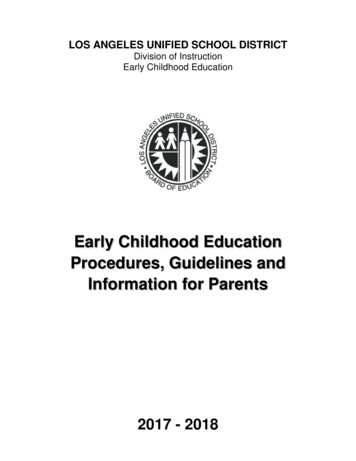
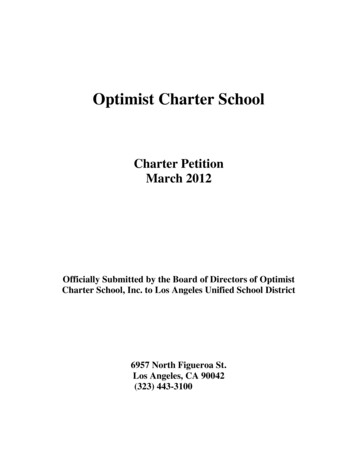

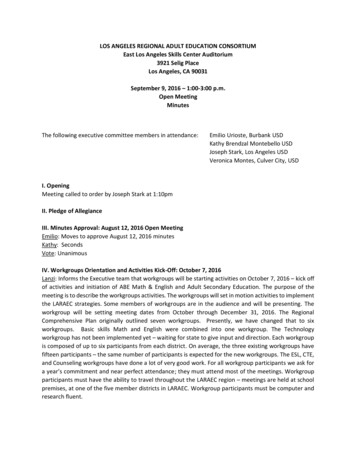
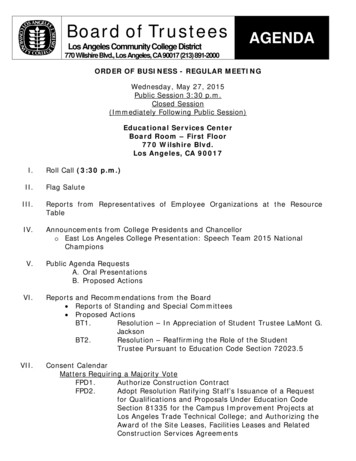
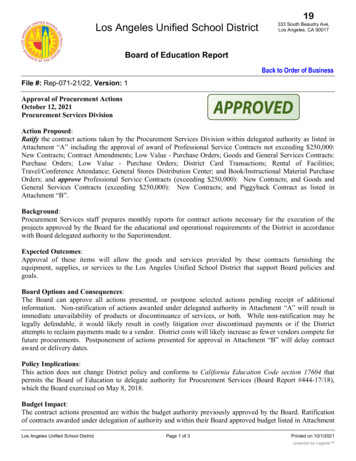
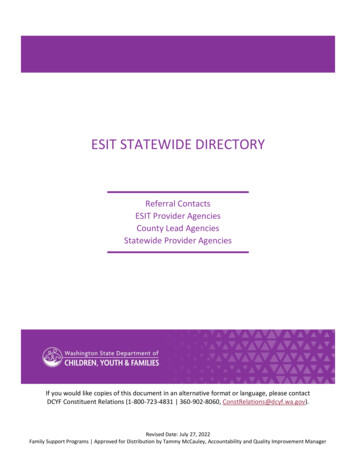
![bTBiesaFn Ep k BIsðèl EdleyIgsmnwgTTYl - calfund [.] org](/img/39/preschool-toolkit-cambodian.jpg)

